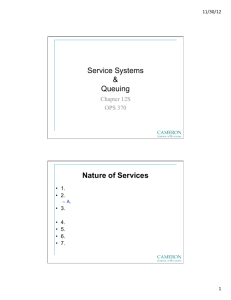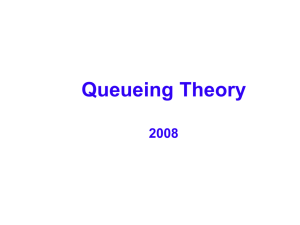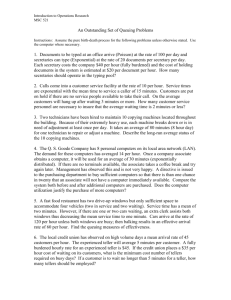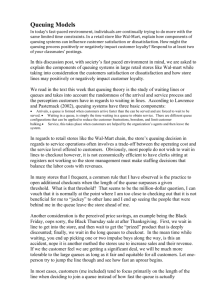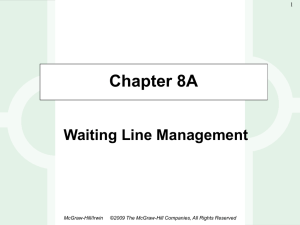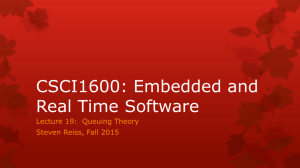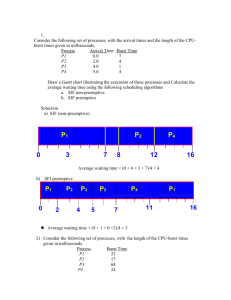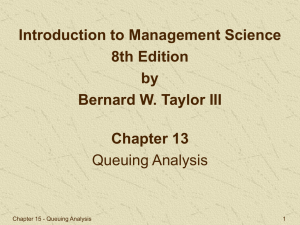SERVICE OPERATIONS AND WAITING LINES
advertisement
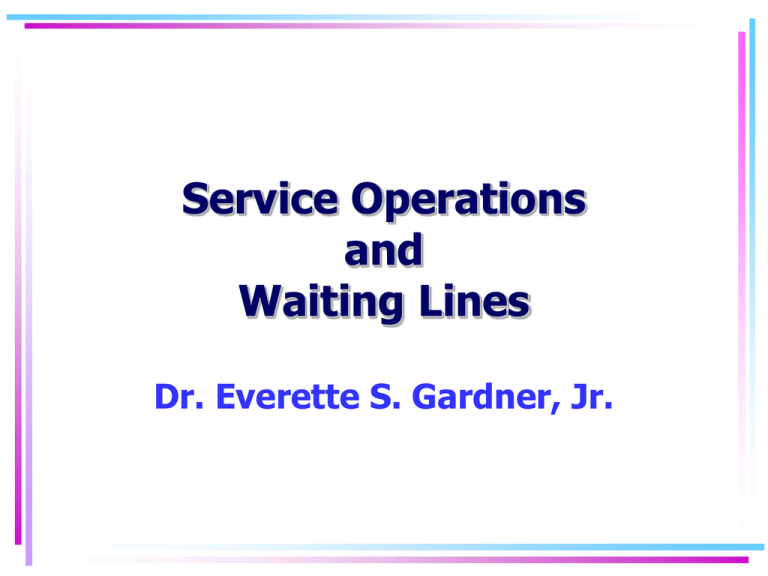
Service Operations and Waiting Lines Dr. Everette S. Gardner, Jr. Case study: Single-server model Reference Vogel, M. A., “Queuing Theory Applied to Machine Manning,” Interfaces, Aug. 79. Company Becton - Dickinson, mfg. of hypodermic needles and syringes Bottom line Cash savings = $575K / yr. Also increased production by 80%. Problem High-speed machines jammed frequently. Attendants cleared jams. How many machines should each attendant monitor? Model Basic single-server: Server—Attendant Customer—Jammed machine Waiting Lines 2 Case study (cont.) Solution procedure Each machine jammed at rate of λ = 60/hr. With M machines, arrival rate to each attendant is λ = 60M Service rate is μ = 450/hr. Utilization ratio = 60M/450 Experimenting with different values of M produced an arrival rate that minimized costs (wages + lost production) M = 5 was optimal, compared to M = 1 before queuing study Waiting Lines 3 Case study: Multiple-server model Reference Deutch, H. and Mabert, V. A., “Queuing Theory Applied to Teller Staffing,” Interfaces, Oct., 1980. Company Bankers Trust Co. of New York Bottom line Annual cash savings of $1,000,000 in reduced wages. Cost to develop model of $110,000. Problem Determine number of tellers to be on duty per hour of day to meet goals for waiting time. Staffing decisions needed at 100 branch banks. Model Straightforward application of multi-channel model in text. Waiting Lines 4 Case study (cont.) Analysis Development of arrival and service distributions by hour and day of week at each bank. Arrival and service shown to be Poisson / Exponential. Experimentation with number of servers in model showed that full-time tellers were idle much of the day. Result Elimination of 100 full-time tellers. Increased use of part-time tellers. Today, the multi-channel model is a standard tool for staffing decisions in banking. Waiting Lines 5 Queuing model structures Single-server model Source pop. Pop. can be finite or infinite Service facility Arrival rate must be Poisson Queue capacity can be finite or infinite Waiting Lines Service time usually exp., but can be anything 6 Queuing model structures (cont.) Multiple-server model Source pop. Pop. must be infinite Arrival rate must be Poisson Queue capacity must be infinite Note: There is only one queue regardless of nbr. of servers Waiting Lines Service facility #1 Service facility #2 Service time for each server must have same mean and be exp. 7 Applying the single-server model 1. Analyze service times. - plot actual vs. exponential distribution - if exponential good fit, use it - otherwise compute σ of times 2. Analyze arrival rates. - plot actual vs. Poisson Distribution - if Poisson good fit, use it - if not, stop—only alternative is simulation 3. Determine queue capacity. - infinite or finite? - if uncertain, compare results from alternative models Waiting Lines 8 Applying the single-server model (cont.) 4. Determine size of source population. - infinite or finite? - if uncertain, compare results from alternative models 5. Choose model from SINGLEQ worksheet. Waiting Lines SINGLEQ.xls 9 Applying the multiple-server model 1. Analyze service times. - Must be exponential 2. Analyze arrival rates. - Must be Poisson 3. Queue capacity must be infinite. 4. Source population must be infinite. 5. Apply MULTIQ worksheet. Waiting Lines MULTIQ.xls 10 Single-server equations Arrival rate = λ Service rate = μ Mean number in queue = λ2/(μ(μ-λ)) Mean number in system = λ /(μ-λ) Mean time in queue = λ /(μ(μ-λ)) Mean time in system = 1/(μ-λ) Utilization ratio (Prob. server is busy) = λ /μ Waiting Lines SINGLEQ.xls 11 Utilization ratio vs. queue length λ 5 10 15 19 19.5 19.6 19.7 19.8 19.9 19.95 19.99 μ 20 20 20 20 20 20 20 20 20 20 20 λ/μ .25 .50 .75 .95 .975 .98 .985 .99 .995 .997 .999 20 20 1.000 Queue length 0.08 people 0.50 2.25 18.05 38.03 48.02 64.68 98.01 198.01 398.00 1,998.00 Waiting Lines SINGLEQ.xls 12 Single-server queuing identities A. Number units in system = arrival rate * mean time in system B. Number units in queue = arrival rate * mean time in queue C. Mean time in system = mean time in queue + mean service time Note: Mean service time = 1/ mean service rate If we can determine only one of the following, all other values can be found by substitution: Number units in system or queue Mean time in system or queue Waiting Lines 13 State diagram: single-server model A # in system 0 A 2 1 S A S 3 S ● # in system also called state. ● To get from one state to another, an arrival (a) must occur or a service completion (s) must occur. ● In long-run, for each state: Rate in = Rate out Mean # A = Mean # S Waiting Lines 14 Balance equations for each state State 0 Rate in SP1 = Rate out AP0 Probability in state 1 The only way into state 0 is service completion from 1 Probability in state 0 The only way out of state 0 is to have an arrival Waiting Lines 15 Balance equations for each state (cont.) State 1 Rate in AP0 + SP2 = = Can arrive state 1 by arrival from 0 or service completion from 2 Rate out AP1 + SP1 Two ways out of state 1, arrival or service completion 2 AP1 + SP3 = AP2 + SP2 3 AP2 + SP4 = AP3 + SP3 etc. Waiting Lines 16 Solution of balance equations Expected number in system = ΣnPn Solve equations simultaneously to get each probability. Given number in system, all other values are found by substitution in queuing identities. Waiting Lines 17

